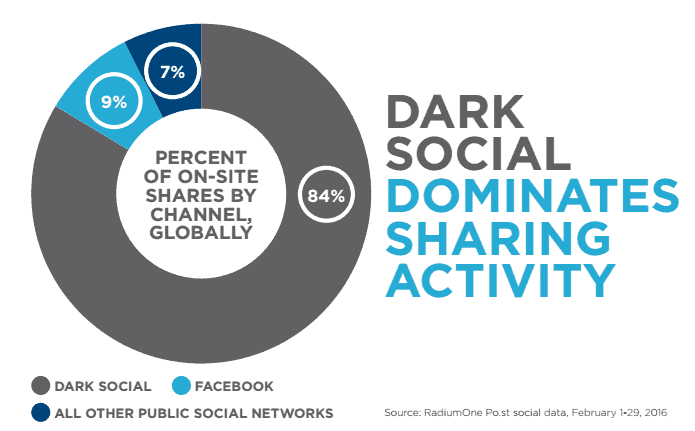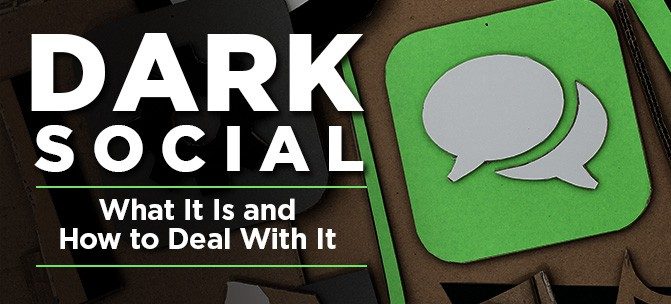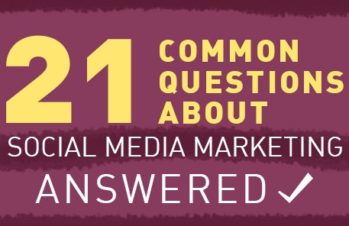The Dark Ages, the dark side of the moon, fear of the dark… What do all of these references to the dark have in common? Ignorance, or the unknown. And that’s exactly what dark social is all about.
Dark social refers to the ubiquitous practice of sharing content privately; that is, not sharing something openly via social media, where shares can be tracked by companies, but instead, cutting and pasting links or even whole blog posts into emails to send them to friends.
This creates a dark spot for businesses and marketers trying to keep tabs on where their web traffic is coming from, and which content is encouraging engagement.
And this dark spot is significant. According to a June 2016 report from RadiumOne, 82 percent of content shared on mobile is shared through dark social – via messaging apps, email, or text. That’s up from less than 50 percent in 2014.
82 percent of content shared on mobile is shared through dark social, according to a report by @RadiumOne. Click To TweetAnd although we’re all very familiar with Facebook’s “share” button, it turns out we don’t use it as often as we might think. Just 13 percent of content on mobile is shared via Facebook, and 10 percent on all other social networks.
Worst of all, sometimes, in all the cutting and pasting, great content can be shared without giving credit to its source – which defeats the purpose of writing marketing content!
To get an idea of how much of an impact dark social has on your traffic, take a look at this chart from RadiumOne:

So where does all this dark social traffic come from? The biggest sources are:
- SMS and messaging apps like WhatsApp, Facebook Messenger, Snapchat, Slack, and Google Hangouts
- Private or secure browsers, like Google Chrome’s Incognito mode
Is there a way to deal with dark social, remove this blind spot in the analytics, and ensure that no matter how your content is shared, your company’s name will remain attached to it?
Well – yes and no.
Let me tell you about my marketing agency’s first experience with the dark side of dark social.
We had written a beautiful, moving tribute piece to public safety officials for one of our clients. We were hoping that it would go viral on social media, garnering massive engagement and driving tons of traffic to the client’s website.
As soon as it went live, we posted the link on Facebook and sat back to watch the fun.
And we weren’t disappointed. Instantly, the online public safety community reacted with likes, shares, and comments.
But here’s where things got frustrating. Someone cut and pasted the text of the blog post from our client’s site onto their community page – but without the paragraphs naming our client as the source, and without posting the link to give credit, either.
It was just the piece alone, with no context or credit given…and that post proceeded to go viral! What should have been a triumphant social media win for our client turned into mounting frustration, with each share, like, and comment asking who had written such a wonderful tribute making our indignation grow.
Of course, the post continued to do well in other avenues as well – avenues that did include the link – so all in all, it was still a great success. But those hundreds of social media interactions we missed out on rankled. So here’s what we did.
Our graphic design department created a lovely background image on which to place the text of the tribute. Then, at the bottom of that image, we included a line giving credit to our client. We placed this image on the blog page and began sharing it on social media as well.
Immediately, we saw a difference in the way people responded. Because the image was now an integral part of the tribute, they wanted to share it, too – not just the text.
So the message remained intact, including the line naming our client. We even managed to alert those who had only seen the cut and pasted text to this new and improved version, and successfully diverted their attention to the original.
Phew! Disaster averted, and virality achieved.
So what’s the takeaway here? First, make sure your company’s association with every piece of content you share is made clear beyond a shadow of a doubt.
It’s not enough to mention your company once or twice at the beginning or end of a piece. Interweave mentions of your company throughout each piece, so that removing them would damage its integrity, and defeat the purpose of sharing it. And if that approach doesn’t fit a particular blog post, then get creative as we did, and attach your name to the content permanently in some other way.
Make sure your company’s association with every piece of content you share is made clear beyond a doubt. #darksocial Click To TweetOf course, there are other ways to help in the fight against dark social, as well.
There are certain tools you can use to help measure your dark social. Creating an advanced segment in Google Analytics that tracks visitors who come to your website via direct search, but don’t go through your homepage (Social Media Today has detailed instructions on how to do this).
You can also track dark social using web tools like GetSocial.io, Sharethis, and Po.st. These tools allow you to track copy and paste sharing by adding small snippets of code to your website.
Another way businesses can track where cut-and-pasted-link traffic is coming from is by attaching URM (Urchin Tracking Module) codes to all of their URLs.
They can also add link-back functionality to their web pages, which automatically includes “Read more at yourwebsite.com” with every cut and paste snippet of text from your site (however, this addition can simply be deleted).
Neither method is 100% foolproof, though, and neither satisfactorily solves the problem of giving credit where credit is due.
One thing to keep in mind, of course, is that dark social shares can be good for your brand, like links shared privately between friends via email or messaging apps. The clickback rates on these kinds of shares are typically high because the links are coming from trusted sources. If a family member or friend emails you a link with a subject line “I thought of you when I read this,” you’re most likely going to click on it – even if you don’t read the entire thing.
Your best bet in combatting dark social is to make every piece of content very obviously yours, whether through the text itself, through graphics, or some other creative means. Once you do this, you won’t have to worry about where your content is shared – while you may not always be able to track it, it will always be doing its job, no matter where it ends up.







